SN 0641-1997
基本信息
标准号: SN 0641-1997
中文名称:出口肉及肉制品中丁烯磷残留量检验方法
标准类别:商检行业标准(SN)
标准状态:现行
出版语种:简体中文
下载格式:.zip .pdf
下载大小:3074919
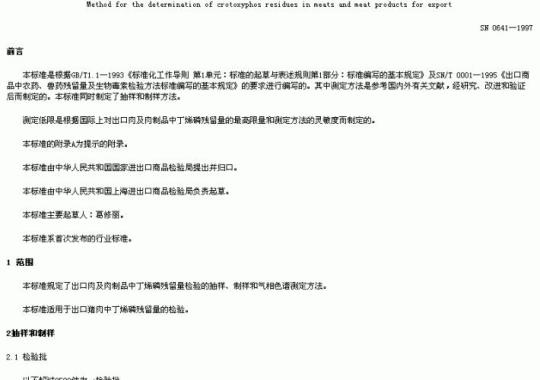
标准分类号
关联标准
出版信息
相关单位信息
标准简介
SN 0641-1997.Method for the determination of crotoxyphos residues in meats and meat products for export.
1范围
SN 0641规定了出口肉及肉制品中丁烯磷残留量检验的抽样、制样和气相色谱测定方法。
SN 0641适用于出口猪肉中丁烯磷残留量的检验。
2抽样和制样
2.1检验批
以不超过2500件为一检验批。
同一检验批的商品应具有相同的特征,如包装、标记、产地、规格和等级等。
2.2抽样数量
批量,件 最低抽样数,件
1~25 1
26~100 5
101~250 10
251~500 15
501~1000 17
1001~2500 20
2.3抽样方法
按2.2规定的抽样件数,随机抽职,逐件开启。从每件中职一袋作为原始样品,其总量不少于2kg,放入清洁容器内,加封后,标明标记,及时送交实验室。
如每件中无小包装或有小包装但每袋重量超过2kg者,则可用灭菌的锋利刀在抽出的包件中,每件割取不少于100 g, 混合后置于清洁容器内,作为混合原始样。混合原始样的重量不少于2kgo加封后,标明标记,及时送交实验室。
2.4试样制备
从原始样品中分取出约1kg,经捣碎机充分捣碎,混匀,均分成两份,分别装入清洁的容器内,作为试样。加封并标明标记。
2. 5试样保存
将试样于-18℃以下冷冻保存。
注:在抽样和制样的操作过程中,必须防止样品受到污染或发生残留物含量的变化。
3测定方法
3.1方法提要
试样中残留的丁烯磷用乙腈水提职,提取液再用三氯甲烷液一液分配净化提职。三氯甲烷提取液经浓缩,残渣用正己烷浸出并经弗罗里硅土柱净化后,用配有火焰光度检测器的气相色谱仪测定,外标法定量。
1范围
SN 0641规定了出口肉及肉制品中丁烯磷残留量检验的抽样、制样和气相色谱测定方法。
SN 0641适用于出口猪肉中丁烯磷残留量的检验。
2抽样和制样
2.1检验批
以不超过2500件为一检验批。
同一检验批的商品应具有相同的特征,如包装、标记、产地、规格和等级等。
2.2抽样数量
批量,件 最低抽样数,件
1~25 1
26~100 5
101~250 10
251~500 15
501~1000 17
1001~2500 20
2.3抽样方法
按2.2规定的抽样件数,随机抽职,逐件开启。从每件中职一袋作为原始样品,其总量不少于2kg,放入清洁容器内,加封后,标明标记,及时送交实验室。
如每件中无小包装或有小包装但每袋重量超过2kg者,则可用灭菌的锋利刀在抽出的包件中,每件割取不少于100 g, 混合后置于清洁容器内,作为混合原始样。混合原始样的重量不少于2kgo加封后,标明标记,及时送交实验室。
2.4试样制备
从原始样品中分取出约1kg,经捣碎机充分捣碎,混匀,均分成两份,分别装入清洁的容器内,作为试样。加封并标明标记。
2. 5试样保存
将试样于-18℃以下冷冻保存。
注:在抽样和制样的操作过程中,必须防止样品受到污染或发生残留物含量的变化。
3测定方法
3.1方法提要
试样中残留的丁烯磷用乙腈水提职,提取液再用三氯甲烷液一液分配净化提职。三氯甲烷提取液经浓缩,残渣用正己烷浸出并经弗罗里硅土柱净化后,用配有火焰光度检测器的气相色谱仪测定,外标法定量。
标准图片预览
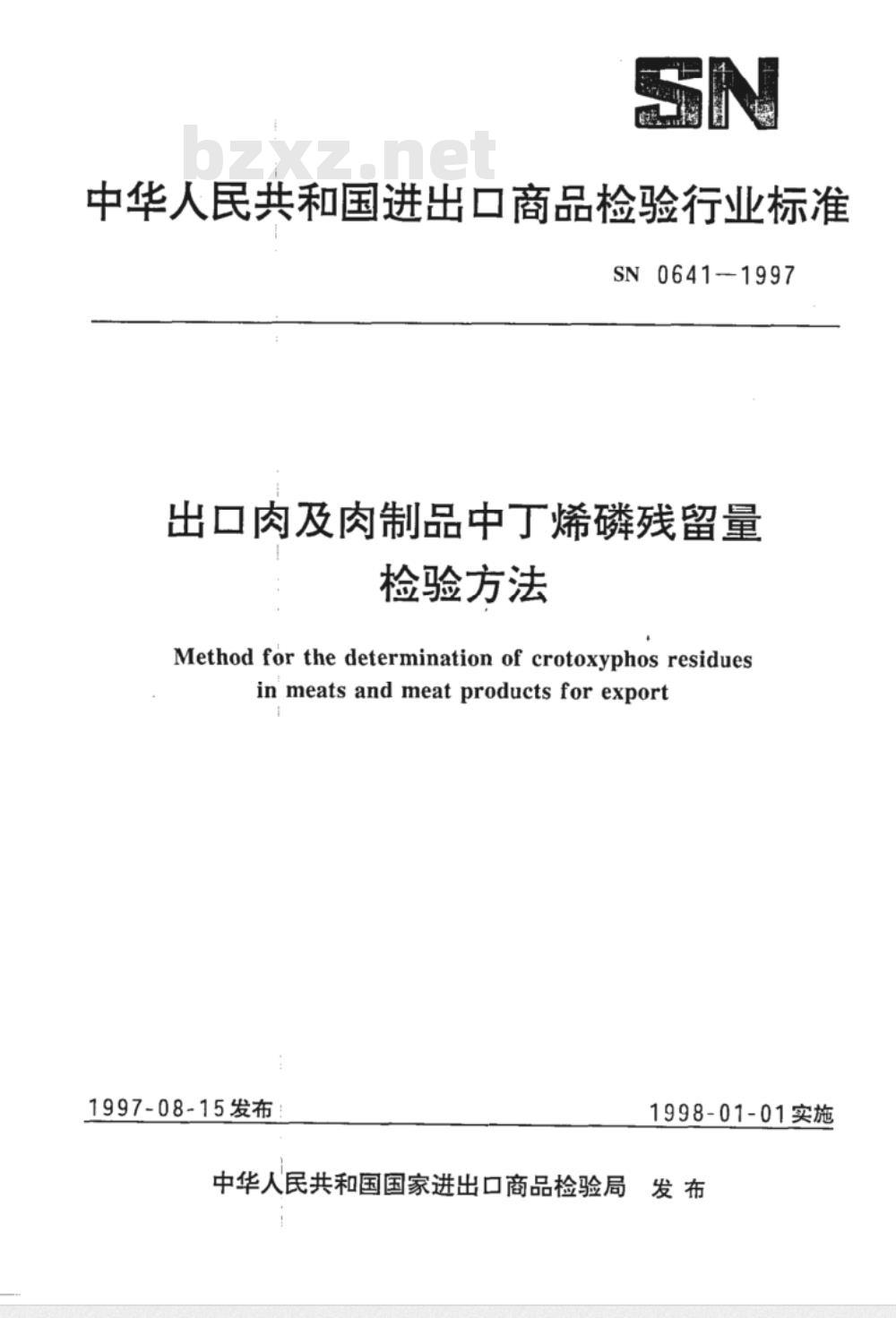
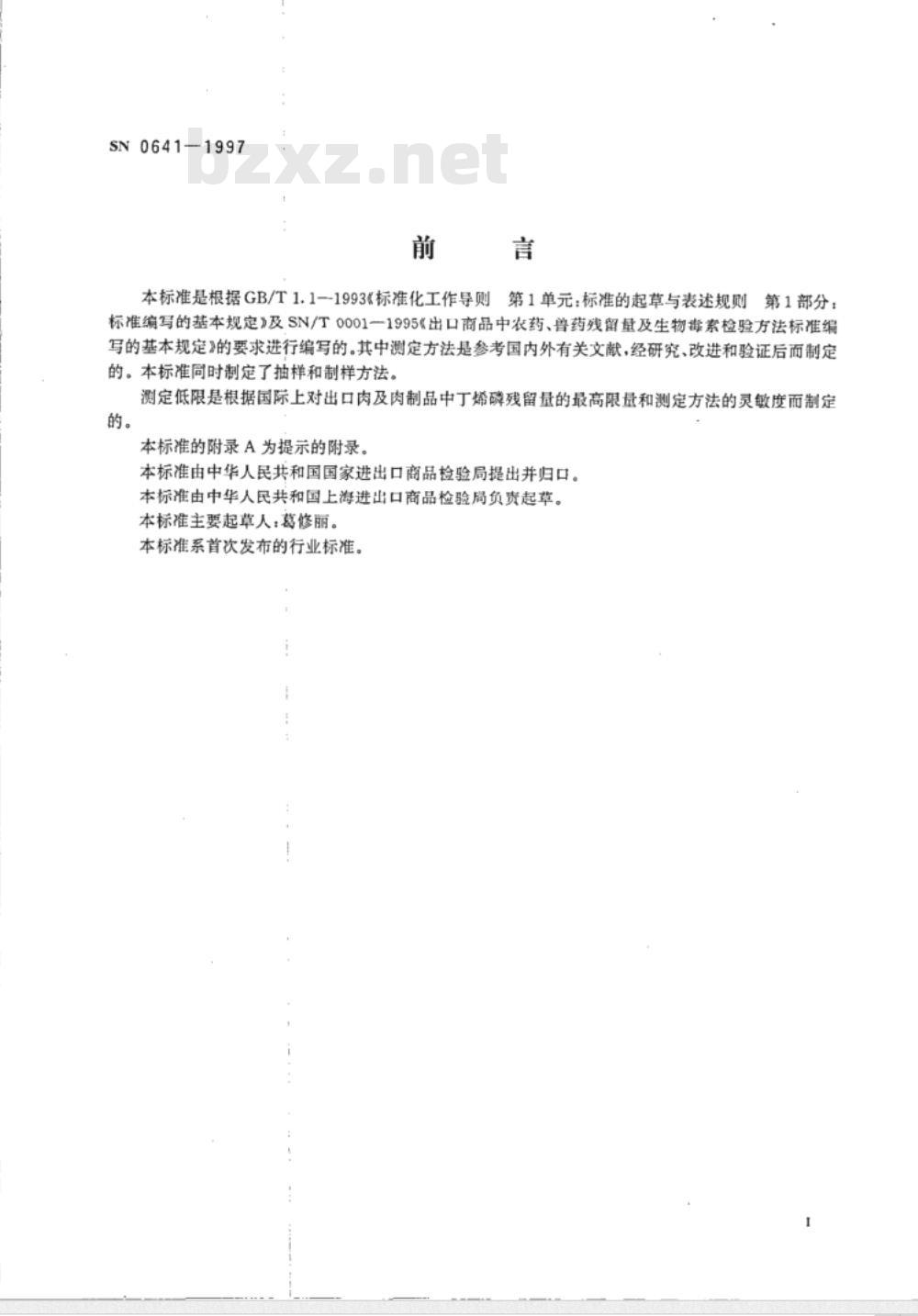
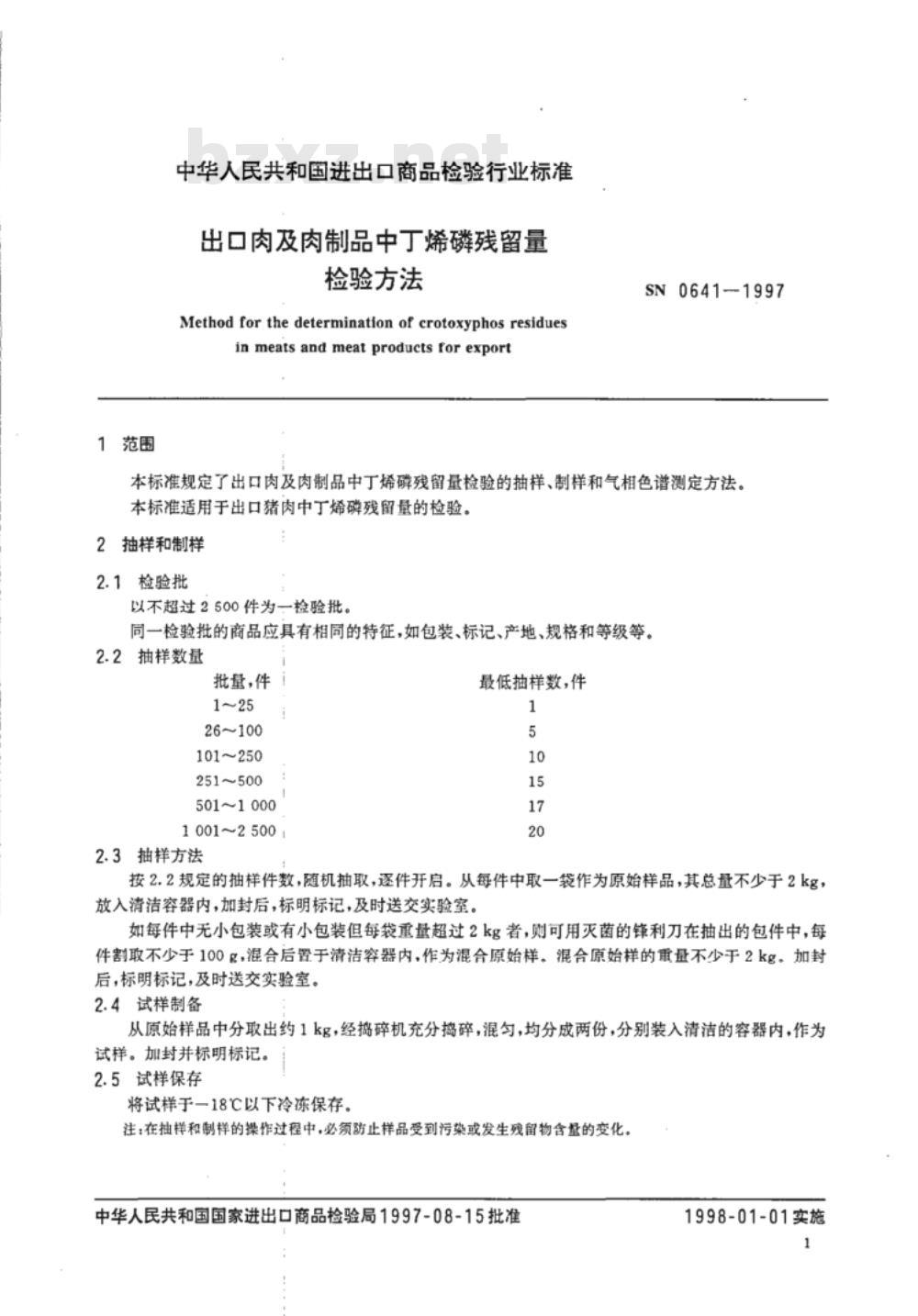
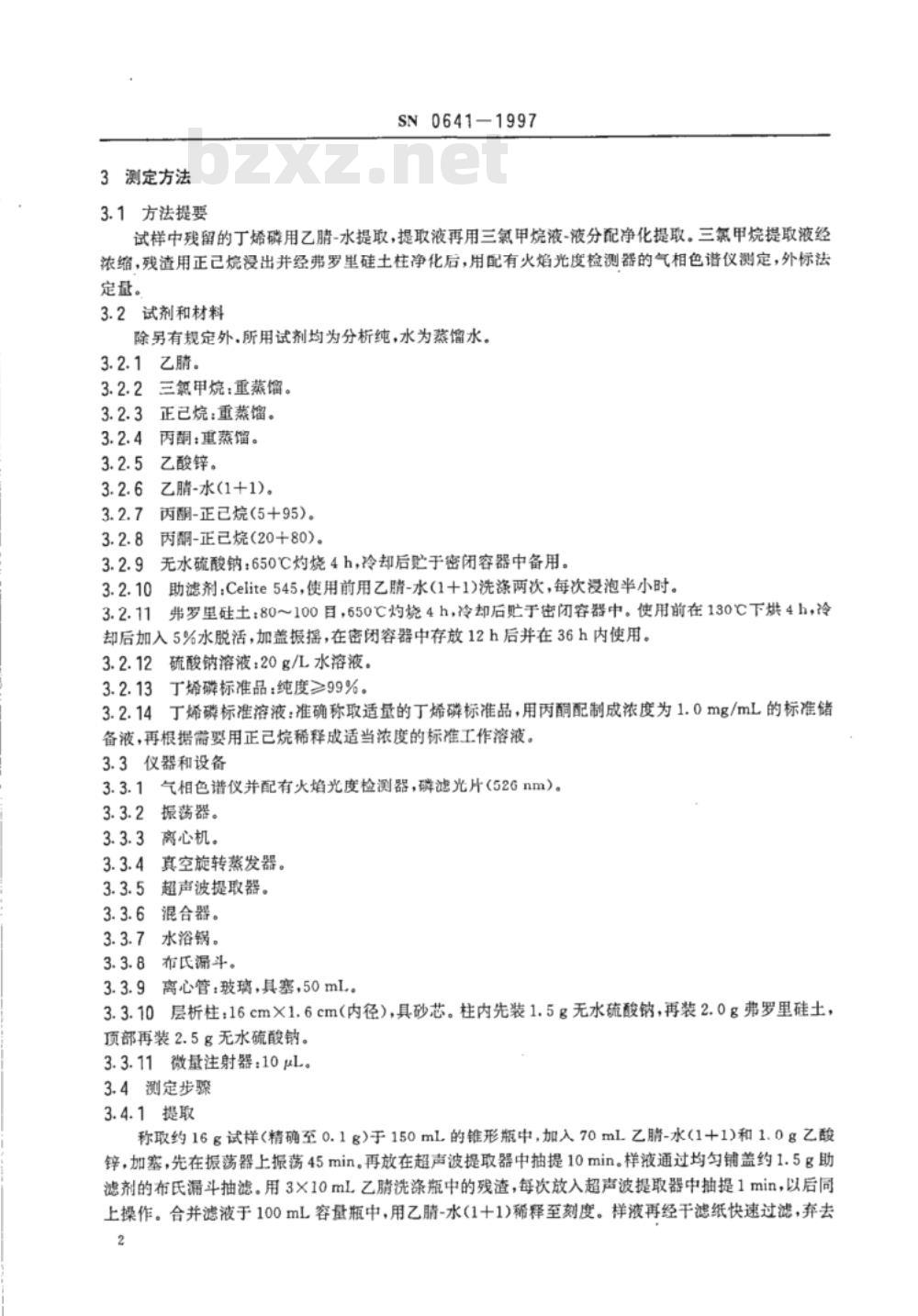
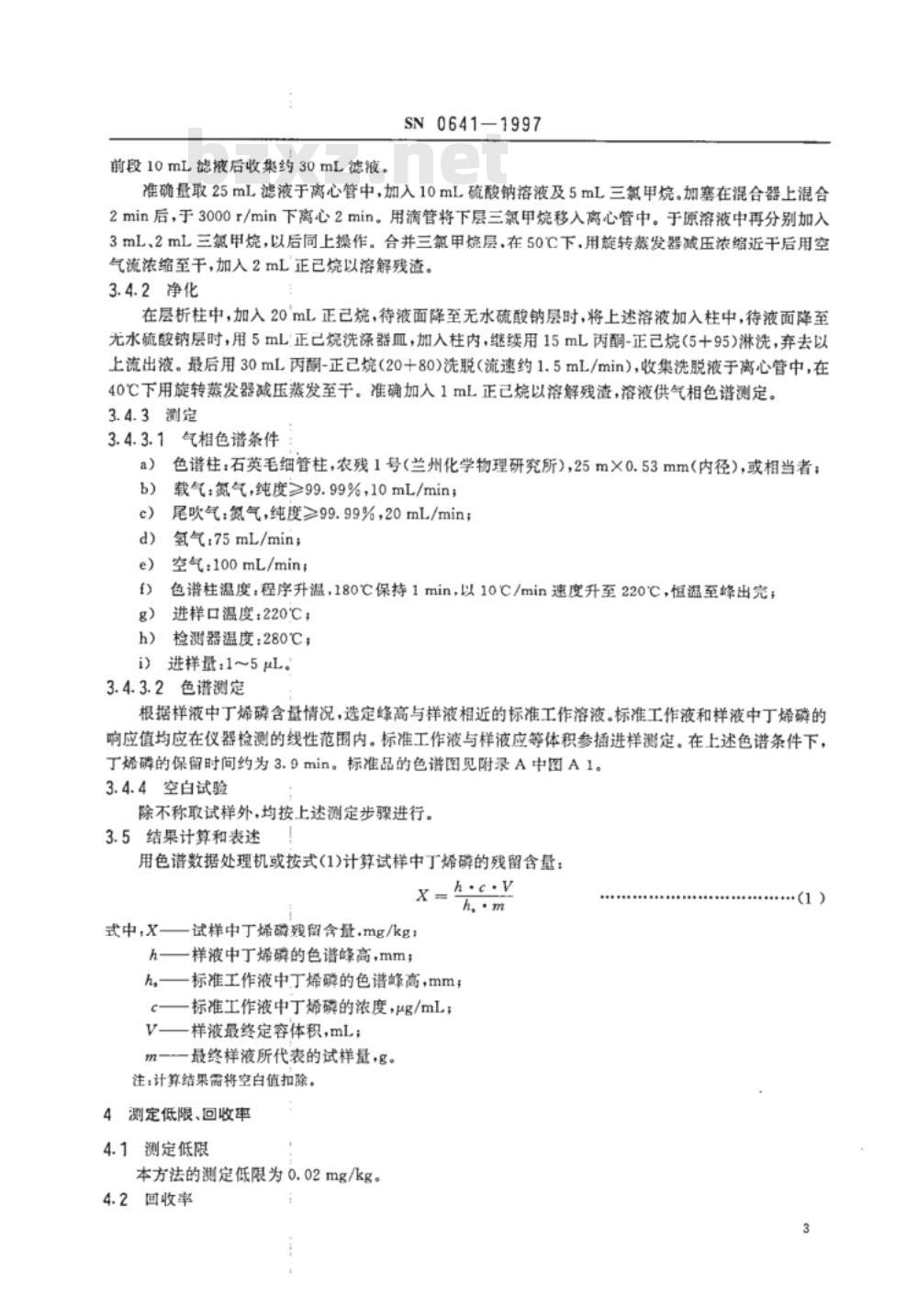
标准内容
中华人民共和国进出口商品检验行业标准SN0641-1997
出口肉及肉制品中丁烯磷残留量检验方法
Method for the determination of crotoxyphos residuesin meats and meat products for export1997-08-15发布
1998-01-01实施
中华人民共和国国家进出口商品检验局发布SN 0641-1997
本标准是根据GB/T1.1一1993《标准化工作导则第1单元:标准的起草与表述规则第1部分:标准编写的基本规定》及SN/T0001一1995《出口商品中农药、兽药残留量及生物毒索检验方法标准编写的基本规定》的要求进行编写的。其中测定方法是参考国内外有关文献,经研究、改进和验证后而制定的。本标准同时制定了抽样和制样方法。的。
测定低限是根据国际上对出口肉及肉制品中丁烯磷残留量的最高限量和测定方法的灵敏度而制定本标准的附录A为提示的附录。
本标准由中华人民共和国国家进出口商品检验局提出并归口。本标准由中华人民共和国上海进出口商品检验局负责起草。本标准主要起草人:葛修丽。
本标准系首次发布的行业标准。1范围
中华人民共和国进出口商品检验行业标准出口肉及肉制品中丁烯磷残留量检验方法
Method for the determination of crotoxyphos residuesinmeatsandmeatproductsforexportSN0641-1997
本标准规定了出口肉及肉制品中丁烯磷残留量检验的抽样、制样和气相色谱测定方法。本标准适用于出口猪肉中丁烯磷残留量的检验。2抽样和制样
2.1检验批
以不超过2500件为一检验批,
同一检验批的商品应具有相同的特征,如包装、标记、产地、规格和等级等。2.2抽样数量
批量,件1
26~100
101~250
251~500
501~1000
1001~2500
2.3抽样方法
最低抽样数,件
按2.2规定的抽样件数,随机抽取,逐件开启。从每件中取一袋作为原始样品,其总量不少于2kg,放入清洁容器内,加封后,标明标记,及时送交实验室。如每件中无小包装或有小包装但每袋重量超过2kg者,则可用灭菌的锋利刀在抽出的包件中,每件割取不少于100g,混合后置于清洁容器内,作为混合原始样。混合原始样的重量不少于2kg。加封后,标明标记,及时送交实验室。2.4试样制备
从原始样品中分取出约1kg,经捣碎机充分捣碎,混匀,均分成两份,分别装入清洁的容器内,作为试样。加封并标明标记。
2.5试样保存
将试样于一18℃以下冷冻保存。注:在抽样和制样的操作过程中,必须防止样品受到污染或发生残留物含量的变化。中华人民共和国国家进出口商品检验局1997-08-15批准1998-01-01实施
3测定方法
SN0641-1997
3.1方法提要
试样中残留的丁烯磷用乙腈-水提取,提取液再用三氯甲烷液-液分配净化提取。三氟甲烷提取液经浓缩,残渣用正已烷浸出并经弗罗里硅土柱净化后,用配有火焰光度检测器的气相色谱仪测定,外标法定量。
3.2试剂和材料
除另有规定外,所用试剂均为分析纯,水为蒸馏水。3.2.1乙腈。
3.2.2三氮甲烷:重蒸馏。
3.2.3正已烷:重蒸馏。
3.2.4丙酮:重蒸馏。
3.2.5乙酸锌。
3.2.6乙-水(1+1)。
丙酮-正已烷(5十95)。
丙酮-正已烷(20十80)。
无水硫酸钠:650℃灼烧4h,冷却后贮于密闭容器中备用。3.2.10
助滤剂:Celite545,使用前用乙睛-水(1+1)洗涤两次,每次浸泡半小时。弗罗里硅土:80100目,650℃灼烧4h,冷却后贴于密闭容器中。使用前在130℃下烘4h,冷却后加入5%水脱活,加盖振摇,在密闭容器中存放12h后并在36h内使用。硫酸钠溶液:20g/L水溶液。
丁烯磷标准品:纯度≥99%。
丁烯磷标准溶液:准确称取适量的丁烯磷标准品,用丙酮配制成浓度为1.0mg/mL的标准储3.2.14
备液,再根据需要用正已烷稀释成适当浓度的标准工作溶液。3.3仪器和设备
气相色谱仪并配有火焰光度检测器,磷滤光片(52Gnm)。3.3.1
3.3.2振荡器。
离心机。
真空旋转蒸发器。
超声波提取器。
混合器。
水浴锅。
3布氏漏斗。
3.3.9离心管:玻璃,具塞,50mL。3.3.10层析柱:16cm×1.6cm(内径),具砂芯。柱内先装1.5g无水硫酸钠,再装2.0g弗罗里硅土,顶部再装2.5g无水硫酸钠。
3.3.11微量注射器:10μL。
3.4测定步骤wwW.bzxz.Net
3.4.1提取
称取约16g试样(精确至0.1g)于150mL的锥形瓶中,加入70mL乙-水(1+1)和1.0g乙酸锌,加塞,先在振荡器上振荡45min。再放在超声波提取器中抽提10min。样液通过均匀铺盖约1.5g助滤剂的布氏漏斗抽滤。用3×10mL乙腈洗涤瓶中的残渣,每次放入超声波提取器中抽提1min,以后同上操作。合并滤液于100mL容量瓶中,用乙腈-水(1十1)稀释至刻度。样液再经干滤纸快速过滤,弃去2
前段10mL滤液后收集约30mL德液。SN0641-1997
准确量取25mL滤液于离心管中,加入10mL硫酸钠溶液及5mL三氧甲烷。加塞在混合器上混合2min后,于3000r/min下离心2min。用滴管将下层三氯甲烷移入离心管中。于原溶液中再分别加入3mL、2mL三氮甲烷,以后同上操作。合并三氟甲烷层.在50℃下.用旋转蒸发器减压浓缩近干后用空气流浓缩至干,加入2mL正已烷以溶解残渣。3.4.2净化
在层析柱中,加入20mL正已烷,待液面降至无水硫酸钠层时,将上述溶液加入柱中,待液面降至无水硫酸钠层时,用5mL正已烷洗涤器皿,加入柱内,继续用15mL丙酮-正已烷(5+95)淋洗,弃去以上流出液。最后用30mL丙酮-正已烷(20十80)洗脱(流速约1.5mL/min),收集洗脱液于离心管中,在40℃下用旋转蒸发器减压蒸发至干。准确加入1mL正已烷以溶解残渣,溶液供气相色谱测定。3.4.3测定
3.4.3.1气相色谱条件
色谱柱:石英毛细管柱,农残1号(兰州化学物理研究所),25mX0.53mm(内径),或相当者;a)
载气:氮气,纯度≥99.99%,10mL/min;e)
尾吹气:氮气,纯度≥99.99%,20mL/min;氢气:75mL/min;
空气:100mL/min;
色谱柱温度:程序升温,180℃保持1min,以10C/min速度升至220°℃,恒温至峰出完;进样口温度:220℃;
检测器温度:280℃C;
i)进样量:1~5μL。
3.4.3.2色谱测定
根据样液中丁烯磷含量情况,选定峰高与样液相近的标准工作溶液。标准工作液和样液中丁烯磷的响应值均应在仪器检测的线性范围内。标准工作液与样液应等体积参插进样测定。在上述色谱条件下,丁烯磷的保留时间约为3.9min。标准品的色谱图见附录A中图A1。3.4.4空白试验
除不称取试样外,均按上述测定步骤进行。3.5结果计算和表述
用色谱数据处理机或按式(1)计算试样中丁烯磷的残留含量:X
式中:X
试样中丁烯磷残留含量,mg/kg:样液中丁烯磷的色谱峰高,mm;h.c.v
标准工作液中丁烯磷的色谱峰高,mm标准工作液中丁烯磷的浓度,Hg/mL;样液最终定容体积,mL;
m—最终样液所代表的试样量,g。注:计算结果需将空白值扣除。4测定低限、回收率
4.1测定低限
本方法的测定低限为0.02mg/kg。4.2回收率
SN0641-1997
猪肉中丁烯磷的添加浓度及其回收率的实验数据:0.02mg/kg时,回收率为97.0%;0.05mg/kg时,回收率为100%;
2.00mg/kg时,回收率为102%。
SN0641-1997
附录A
(提示的附录)
标准品色谱图
图A1丁烯磷标准品的色谱图
SN0641-1997
Foreword
This standard was drafted in accordance with the requirements of GB/T 1.1-1993“Directivesfor the work of standardization--Unit 1:Drafting and presentation of standardsPart 1,Gencral rulesfor drafting standards\and SN/T 001-1995\General rules for drafting the standard methods for thedetermination of pesticide,veterinary drug residues and biotoxins in commodities for export\. Themethod of determination of this standard was drafted by referring to relevant domestic and foreign lit-eratures through research,modification and verification.In addition,methods of sampling and samplepreparationarealso specified inthis standard.The limit of determination in this standard is defined on the basis of the current internationalmaximum limits for crotoxyphos residues in meats and meat products and the sensitivity of themethod.
Annex Aof this standard is an informativeannex.This standard was proposed by and is under the charge of the State Administration of Import andExport Commodity Inspection ofthePeople's Republic of China.This standard was drafted by Shanghai Import and Export Commodity Inspection Bureau of thePeople'sRepublic of China.
The main drafter of this standard is Ge Xiuli.This standard is a professional standard promulgated for the first time.Note:This English version,a translation from the Chinese text,is solely for guidance.Professional Standardof thePeople'sRepublic of ChinaforImportandExportCommodityInspectionMethod for the determination of crotoxyphos residuessN 0641-1997in meats and meat products for export1Scope
This standard specifies the methods of sampling,sample preparation and determination by gaschromatography of crotoxyphos residues in meats and meat products for export.This standard is applicable to the determination of crotoxyphos residues in pork for export.2Samplingand samplepreparation2.1Inspectionlot
Each inspectionlot shouldnotexceed2500packages.The characteristies of the cargo within the same inspection lot,such as packing,mark,origin,specification,grade etc.,should be the same.2.2Quantityofsampletaken
Number of packages
ineachinspectionlot
26—100
101—250
251-500
501-1000
100i—2500
Minimum number of
packages tobetaken
2.3Samplingprocedure
A number of packages specified in 2. 2 are taken at random and opened one by one. From eachpackage,at least one bag shall be taken as a primary sample. The total weight of all the primary samples should not be less than 2 kg,which shall be placed in a clean container,sealed,labeled and sent tothe laboratory in time.
In case the meat pieces are not contained in small bags inside each package,or if there are smallbags inside but the content of bag exceeds 2 kgcut out a part from the meat in each package of notless than 100 g with a disinfected sharp knife. Mix the parts of the meat as the mixed primary sample,which shall not be less than 2 kg.Place in a clean container,seal,label,and send to the laboratory intime.
Approved by the StateAdministration ofImportandExportCommodityInspectionofthe People's Republic of China on Aug.15,1997Implemented from Jan.1.1998
SN0641-1997
2.4Preparationoftestsample
Reduce the combined primary sample to ca 1 kg. Blend in a blender and homogenize thoroughly.Mix and divide into two equal portions,each is placed in a clean container as the test sample,which isthen sealed and labeled.
2.5Storage oftest sample
The test sample should be stored below --18C.Note:In the course of sampling and sample preparation+precautions must be taken to avoid contamination or anyfactors which may cause the change of residue content.Methodof determination
3.1Principle
The crotoxyphos residues in the test sample are extracted with acetonitrile-water.The extract istreated by chloroform liquid-liquid partitioning,and the chloroform extract is evaporated. The residueis dissolved in n-hexane,then the solution is cleaned up by passing through a florisil column.Determi-nation is made by gas chromatograph with flame photometric detector,using external standardmethod.
3.2 Reagents and materials
Unless otherwise specified,the reagents should be analytically pure,\water\is distilled water.3.2.1 Acetonitrile.
3.2.2 Chloroform:Redistilled.3.2.3 n-Hexane:Redistilled.
3.2.4 Acetone:Redistilled.
3.2.5Zinc acetate.
3.2.6 Acetonitrile-water(1+1).3.2.7 Acetone-n-hexane(5+95)3.2.8 Acetone-n-hexane(20+80).3.2.9Anhydrous sodium sulfate:Ignite at 650C for 4 h,and keep in a tightly closed container.3. 2.10Filter aid:Celite 545,wash twice with acetonitrile-water(1+1) before use.Each time let soakin the washing solution for 0. 5 h.3.2.11Florisil;80100 mesh.Ignite at 650C for 4 h,and keep in a tightly closed container aftercooling.Prior to use dry at 130C for 4 h,and after cooling deactivate by adding 5% of water.keep ina closed container fornot less than12 h andusewithin36h.3.2.12 Sodium sulfate solution:20 g/L aqueous solution.3.2.13Crotoxyphos standard:Purity≥99%.Crotoxyphos standard solution:Accurately weigh an adequate amount of crotoxyphos stan-3.2.14
dard,dissolve in acetone to prepare a solution of 1.Omg/mL in concentration as the standard stock so-lution.According to the requircmcnt,prcparc a standard working solution of appropriate concentrationby diluting the stock solution with n-hexane.3.3Apparatus and equipment
3.3.1 Gas chromatograph,equipped with flame photometric detector and phosphorus filter(526nm).
3.3.2Shaker.
3.3.3 Centrifuge.
3.3.4Rotaryvacuumevaporator.3.3.5Ultrasonicextractor.
3.3.6Mixer.
3.3.7 Water-bath.
3.3.8 Buchner funnel.
SN0641--1997
3.3.9Centrifuge tube:Glass,with stopper,50mL.3.3.10Chromatographic.column;16 cmX1.6 cm(id),with sintered glass.Add in sequence 1.5 g ofanhydrous sodium sulfate,2 g of florisil and 2 g of anhydrous sodium sulfate.3.3.11Micro-syringe:10 μL.
3.4Procedure
3.4.1Extraction
Weigh ca 16 g of the test sample( acemrate to 0.1 g) into a 150 mL conical flask,add 70 mL ofacetonitrile-water(1+1) and 1 g of zinc acetate,stopper and extract for 45 min on a shaker,then extract for 10 min in an ultrasonic extractor. Filter by suction through a Buchner funnel which is paddedwith 1. 5 g of filter aid evenly. The residue in the flask is washed with 3X10 mL of acetonitrile.Eachtime extract for 1 min in ultrasonic extractor,then filter as above. Combine the filtrates into a 100 mLvolumetric flask and make up to volume with acetonitrile-water(1+1).Filter the solution through adry filter paper rapidly.Discard the first 10 mL of the filtrate,then collect ca 30 mL of the next.Pipet exactly 25 mL of the filtrate into a centrifuge tube, add 10 mL of sodium sulfate solutionand 5mL of chloroform,stopper and mix violently in a mixer for 2 min.Centrifugalize at 3ooo r/minfor 2 min.Pipet the chloroform(low layer) into a centrifuge tube.Repeat the above procedure with 3mL, 2mL of chloroform. Combined the extracts and concentrate to near dryness on a rotary vacuumevaporator at 5o'C ,then evaporate to dryness under a stream of air.Dissolve the residue with 2 mL ofn-hexane.
3.4.2Cleanup
Rinse the chromatographic column with 20 mL of n-hexane.When the liquid level lowers to theupper surface of anhydrous sodium sulfate,pour the above solution into the column.Wash the container with 5 mL of n-hexane,and pour the washings into the column. When the solution drains to the sur.face of the sodium sulfate add 15 mL of acetone-n-hexane(5+95).Discard all the effluents.Elute with30 mL of acetone-n-hexane(20+80) and collect the eluate into a centrifuge tube( controlling the flowrate at ca 1.5 mL/min).Evaporate to dryness on a rotary vacuum evaporator at 4o'C.Add exactly1mL of n-hexane to dissolve the residue,the solution is ready for GC determination.3.4.3determination
3.4.3.1GCoperatingcondition
a)GC column;Fused-silica capillary column,NONGCAN No.1(Lanzhou Institute of Chemico-physics),25mX0.53mm(id)ortheequivalent;b)Carriergas:Nitrogen,purity≥99.99%,10mL/min;c)Makeupgas:Nitrogen,purity≥99.99%,20mL/min;d)Hydrogen:75 mL/min;
e)Air.100 mL/min;
f)Column temperature:Temperatureprogrammed:Keepat180Cfor1min,then raise(10'C/min)to220,keepat22oCuntilnomorepeakappears;g)Injectionporttemperature:220C;9
小提示:此标准内容仅展示完整标准里的部分截取内容,若需要完整标准请到上方自行免费下载完整标准文档。
出口肉及肉制品中丁烯磷残留量检验方法
Method for the determination of crotoxyphos residuesin meats and meat products for export1997-08-15发布
1998-01-01实施
中华人民共和国国家进出口商品检验局发布SN 0641-1997
本标准是根据GB/T1.1一1993《标准化工作导则第1单元:标准的起草与表述规则第1部分:标准编写的基本规定》及SN/T0001一1995《出口商品中农药、兽药残留量及生物毒索检验方法标准编写的基本规定》的要求进行编写的。其中测定方法是参考国内外有关文献,经研究、改进和验证后而制定的。本标准同时制定了抽样和制样方法。的。
测定低限是根据国际上对出口肉及肉制品中丁烯磷残留量的最高限量和测定方法的灵敏度而制定本标准的附录A为提示的附录。
本标准由中华人民共和国国家进出口商品检验局提出并归口。本标准由中华人民共和国上海进出口商品检验局负责起草。本标准主要起草人:葛修丽。
本标准系首次发布的行业标准。1范围
中华人民共和国进出口商品检验行业标准出口肉及肉制品中丁烯磷残留量检验方法
Method for the determination of crotoxyphos residuesinmeatsandmeatproductsforexportSN0641-1997
本标准规定了出口肉及肉制品中丁烯磷残留量检验的抽样、制样和气相色谱测定方法。本标准适用于出口猪肉中丁烯磷残留量的检验。2抽样和制样
2.1检验批
以不超过2500件为一检验批,
同一检验批的商品应具有相同的特征,如包装、标记、产地、规格和等级等。2.2抽样数量
批量,件1
26~100
101~250
251~500
501~1000
1001~2500
2.3抽样方法
最低抽样数,件
按2.2规定的抽样件数,随机抽取,逐件开启。从每件中取一袋作为原始样品,其总量不少于2kg,放入清洁容器内,加封后,标明标记,及时送交实验室。如每件中无小包装或有小包装但每袋重量超过2kg者,则可用灭菌的锋利刀在抽出的包件中,每件割取不少于100g,混合后置于清洁容器内,作为混合原始样。混合原始样的重量不少于2kg。加封后,标明标记,及时送交实验室。2.4试样制备
从原始样品中分取出约1kg,经捣碎机充分捣碎,混匀,均分成两份,分别装入清洁的容器内,作为试样。加封并标明标记。
2.5试样保存
将试样于一18℃以下冷冻保存。注:在抽样和制样的操作过程中,必须防止样品受到污染或发生残留物含量的变化。中华人民共和国国家进出口商品检验局1997-08-15批准1998-01-01实施
3测定方法
SN0641-1997
3.1方法提要
试样中残留的丁烯磷用乙腈-水提取,提取液再用三氯甲烷液-液分配净化提取。三氟甲烷提取液经浓缩,残渣用正已烷浸出并经弗罗里硅土柱净化后,用配有火焰光度检测器的气相色谱仪测定,外标法定量。
3.2试剂和材料
除另有规定外,所用试剂均为分析纯,水为蒸馏水。3.2.1乙腈。
3.2.2三氮甲烷:重蒸馏。
3.2.3正已烷:重蒸馏。
3.2.4丙酮:重蒸馏。
3.2.5乙酸锌。
3.2.6乙-水(1+1)。
丙酮-正已烷(5十95)。
丙酮-正已烷(20十80)。
无水硫酸钠:650℃灼烧4h,冷却后贮于密闭容器中备用。3.2.10
助滤剂:Celite545,使用前用乙睛-水(1+1)洗涤两次,每次浸泡半小时。弗罗里硅土:80100目,650℃灼烧4h,冷却后贴于密闭容器中。使用前在130℃下烘4h,冷却后加入5%水脱活,加盖振摇,在密闭容器中存放12h后并在36h内使用。硫酸钠溶液:20g/L水溶液。
丁烯磷标准品:纯度≥99%。
丁烯磷标准溶液:准确称取适量的丁烯磷标准品,用丙酮配制成浓度为1.0mg/mL的标准储3.2.14
备液,再根据需要用正已烷稀释成适当浓度的标准工作溶液。3.3仪器和设备
气相色谱仪并配有火焰光度检测器,磷滤光片(52Gnm)。3.3.1
3.3.2振荡器。
离心机。
真空旋转蒸发器。
超声波提取器。
混合器。
水浴锅。
3布氏漏斗。
3.3.9离心管:玻璃,具塞,50mL。3.3.10层析柱:16cm×1.6cm(内径),具砂芯。柱内先装1.5g无水硫酸钠,再装2.0g弗罗里硅土,顶部再装2.5g无水硫酸钠。
3.3.11微量注射器:10μL。
3.4测定步骤wwW.bzxz.Net
3.4.1提取
称取约16g试样(精确至0.1g)于150mL的锥形瓶中,加入70mL乙-水(1+1)和1.0g乙酸锌,加塞,先在振荡器上振荡45min。再放在超声波提取器中抽提10min。样液通过均匀铺盖约1.5g助滤剂的布氏漏斗抽滤。用3×10mL乙腈洗涤瓶中的残渣,每次放入超声波提取器中抽提1min,以后同上操作。合并滤液于100mL容量瓶中,用乙腈-水(1十1)稀释至刻度。样液再经干滤纸快速过滤,弃去2
前段10mL滤液后收集约30mL德液。SN0641-1997
准确量取25mL滤液于离心管中,加入10mL硫酸钠溶液及5mL三氧甲烷。加塞在混合器上混合2min后,于3000r/min下离心2min。用滴管将下层三氯甲烷移入离心管中。于原溶液中再分别加入3mL、2mL三氮甲烷,以后同上操作。合并三氟甲烷层.在50℃下.用旋转蒸发器减压浓缩近干后用空气流浓缩至干,加入2mL正已烷以溶解残渣。3.4.2净化
在层析柱中,加入20mL正已烷,待液面降至无水硫酸钠层时,将上述溶液加入柱中,待液面降至无水硫酸钠层时,用5mL正已烷洗涤器皿,加入柱内,继续用15mL丙酮-正已烷(5+95)淋洗,弃去以上流出液。最后用30mL丙酮-正已烷(20十80)洗脱(流速约1.5mL/min),收集洗脱液于离心管中,在40℃下用旋转蒸发器减压蒸发至干。准确加入1mL正已烷以溶解残渣,溶液供气相色谱测定。3.4.3测定
3.4.3.1气相色谱条件
色谱柱:石英毛细管柱,农残1号(兰州化学物理研究所),25mX0.53mm(内径),或相当者;a)
载气:氮气,纯度≥99.99%,10mL/min;e)
尾吹气:氮气,纯度≥99.99%,20mL/min;氢气:75mL/min;
空气:100mL/min;
色谱柱温度:程序升温,180℃保持1min,以10C/min速度升至220°℃,恒温至峰出完;进样口温度:220℃;
检测器温度:280℃C;
i)进样量:1~5μL。
3.4.3.2色谱测定
根据样液中丁烯磷含量情况,选定峰高与样液相近的标准工作溶液。标准工作液和样液中丁烯磷的响应值均应在仪器检测的线性范围内。标准工作液与样液应等体积参插进样测定。在上述色谱条件下,丁烯磷的保留时间约为3.9min。标准品的色谱图见附录A中图A1。3.4.4空白试验
除不称取试样外,均按上述测定步骤进行。3.5结果计算和表述
用色谱数据处理机或按式(1)计算试样中丁烯磷的残留含量:X
式中:X
试样中丁烯磷残留含量,mg/kg:样液中丁烯磷的色谱峰高,mm;h.c.v
标准工作液中丁烯磷的色谱峰高,mm标准工作液中丁烯磷的浓度,Hg/mL;样液最终定容体积,mL;
m—最终样液所代表的试样量,g。注:计算结果需将空白值扣除。4测定低限、回收率
4.1测定低限
本方法的测定低限为0.02mg/kg。4.2回收率
SN0641-1997
猪肉中丁烯磷的添加浓度及其回收率的实验数据:0.02mg/kg时,回收率为97.0%;0.05mg/kg时,回收率为100%;
2.00mg/kg时,回收率为102%。
SN0641-1997
附录A
(提示的附录)
标准品色谱图
图A1丁烯磷标准品的色谱图
SN0641-1997
Foreword
This standard was drafted in accordance with the requirements of GB/T 1.1-1993“Directivesfor the work of standardization--Unit 1:Drafting and presentation of standardsPart 1,Gencral rulesfor drafting standards\and SN/T 001-1995\General rules for drafting the standard methods for thedetermination of pesticide,veterinary drug residues and biotoxins in commodities for export\. Themethod of determination of this standard was drafted by referring to relevant domestic and foreign lit-eratures through research,modification and verification.In addition,methods of sampling and samplepreparationarealso specified inthis standard.The limit of determination in this standard is defined on the basis of the current internationalmaximum limits for crotoxyphos residues in meats and meat products and the sensitivity of themethod.
Annex Aof this standard is an informativeannex.This standard was proposed by and is under the charge of the State Administration of Import andExport Commodity Inspection ofthePeople's Republic of China.This standard was drafted by Shanghai Import and Export Commodity Inspection Bureau of thePeople'sRepublic of China.
The main drafter of this standard is Ge Xiuli.This standard is a professional standard promulgated for the first time.Note:This English version,a translation from the Chinese text,is solely for guidance.Professional Standardof thePeople'sRepublic of ChinaforImportandExportCommodityInspectionMethod for the determination of crotoxyphos residuessN 0641-1997in meats and meat products for export1Scope
This standard specifies the methods of sampling,sample preparation and determination by gaschromatography of crotoxyphos residues in meats and meat products for export.This standard is applicable to the determination of crotoxyphos residues in pork for export.2Samplingand samplepreparation2.1Inspectionlot
Each inspectionlot shouldnotexceed2500packages.The characteristies of the cargo within the same inspection lot,such as packing,mark,origin,specification,grade etc.,should be the same.2.2Quantityofsampletaken
Number of packages
ineachinspectionlot
26—100
101—250
251-500
501-1000
100i—2500
Minimum number of
packages tobetaken
2.3Samplingprocedure
A number of packages specified in 2. 2 are taken at random and opened one by one. From eachpackage,at least one bag shall be taken as a primary sample. The total weight of all the primary samples should not be less than 2 kg,which shall be placed in a clean container,sealed,labeled and sent tothe laboratory in time.
In case the meat pieces are not contained in small bags inside each package,or if there are smallbags inside but the content of bag exceeds 2 kgcut out a part from the meat in each package of notless than 100 g with a disinfected sharp knife. Mix the parts of the meat as the mixed primary sample,which shall not be less than 2 kg.Place in a clean container,seal,label,and send to the laboratory intime.
Approved by the StateAdministration ofImportandExportCommodityInspectionofthe People's Republic of China on Aug.15,1997Implemented from Jan.1.1998
SN0641-1997
2.4Preparationoftestsample
Reduce the combined primary sample to ca 1 kg. Blend in a blender and homogenize thoroughly.Mix and divide into two equal portions,each is placed in a clean container as the test sample,which isthen sealed and labeled.
2.5Storage oftest sample
The test sample should be stored below --18C.Note:In the course of sampling and sample preparation+precautions must be taken to avoid contamination or anyfactors which may cause the change of residue content.Methodof determination
3.1Principle
The crotoxyphos residues in the test sample are extracted with acetonitrile-water.The extract istreated by chloroform liquid-liquid partitioning,and the chloroform extract is evaporated. The residueis dissolved in n-hexane,then the solution is cleaned up by passing through a florisil column.Determi-nation is made by gas chromatograph with flame photometric detector,using external standardmethod.
3.2 Reagents and materials
Unless otherwise specified,the reagents should be analytically pure,\water\is distilled water.3.2.1 Acetonitrile.
3.2.2 Chloroform:Redistilled.3.2.3 n-Hexane:Redistilled.
3.2.4 Acetone:Redistilled.
3.2.5Zinc acetate.
3.2.6 Acetonitrile-water(1+1).3.2.7 Acetone-n-hexane(5+95)3.2.8 Acetone-n-hexane(20+80).3.2.9Anhydrous sodium sulfate:Ignite at 650C for 4 h,and keep in a tightly closed container.3. 2.10Filter aid:Celite 545,wash twice with acetonitrile-water(1+1) before use.Each time let soakin the washing solution for 0. 5 h.3.2.11Florisil;80100 mesh.Ignite at 650C for 4 h,and keep in a tightly closed container aftercooling.Prior to use dry at 130C for 4 h,and after cooling deactivate by adding 5% of water.keep ina closed container fornot less than12 h andusewithin36h.3.2.12 Sodium sulfate solution:20 g/L aqueous solution.3.2.13Crotoxyphos standard:Purity≥99%.Crotoxyphos standard solution:Accurately weigh an adequate amount of crotoxyphos stan-3.2.14
dard,dissolve in acetone to prepare a solution of 1.Omg/mL in concentration as the standard stock so-lution.According to the requircmcnt,prcparc a standard working solution of appropriate concentrationby diluting the stock solution with n-hexane.3.3Apparatus and equipment
3.3.1 Gas chromatograph,equipped with flame photometric detector and phosphorus filter(526nm).
3.3.2Shaker.
3.3.3 Centrifuge.
3.3.4Rotaryvacuumevaporator.3.3.5Ultrasonicextractor.
3.3.6Mixer.
3.3.7 Water-bath.
3.3.8 Buchner funnel.
SN0641--1997
3.3.9Centrifuge tube:Glass,with stopper,50mL.3.3.10Chromatographic.column;16 cmX1.6 cm(id),with sintered glass.Add in sequence 1.5 g ofanhydrous sodium sulfate,2 g of florisil and 2 g of anhydrous sodium sulfate.3.3.11Micro-syringe:10 μL.
3.4Procedure
3.4.1Extraction
Weigh ca 16 g of the test sample( acemrate to 0.1 g) into a 150 mL conical flask,add 70 mL ofacetonitrile-water(1+1) and 1 g of zinc acetate,stopper and extract for 45 min on a shaker,then extract for 10 min in an ultrasonic extractor. Filter by suction through a Buchner funnel which is paddedwith 1. 5 g of filter aid evenly. The residue in the flask is washed with 3X10 mL of acetonitrile.Eachtime extract for 1 min in ultrasonic extractor,then filter as above. Combine the filtrates into a 100 mLvolumetric flask and make up to volume with acetonitrile-water(1+1).Filter the solution through adry filter paper rapidly.Discard the first 10 mL of the filtrate,then collect ca 30 mL of the next.Pipet exactly 25 mL of the filtrate into a centrifuge tube, add 10 mL of sodium sulfate solutionand 5mL of chloroform,stopper and mix violently in a mixer for 2 min.Centrifugalize at 3ooo r/minfor 2 min.Pipet the chloroform(low layer) into a centrifuge tube.Repeat the above procedure with 3mL, 2mL of chloroform. Combined the extracts and concentrate to near dryness on a rotary vacuumevaporator at 5o'C ,then evaporate to dryness under a stream of air.Dissolve the residue with 2 mL ofn-hexane.
3.4.2Cleanup
Rinse the chromatographic column with 20 mL of n-hexane.When the liquid level lowers to theupper surface of anhydrous sodium sulfate,pour the above solution into the column.Wash the container with 5 mL of n-hexane,and pour the washings into the column. When the solution drains to the sur.face of the sodium sulfate add 15 mL of acetone-n-hexane(5+95).Discard all the effluents.Elute with30 mL of acetone-n-hexane(20+80) and collect the eluate into a centrifuge tube( controlling the flowrate at ca 1.5 mL/min).Evaporate to dryness on a rotary vacuum evaporator at 4o'C.Add exactly1mL of n-hexane to dissolve the residue,the solution is ready for GC determination.3.4.3determination
3.4.3.1GCoperatingcondition
a)GC column;Fused-silica capillary column,NONGCAN No.1(Lanzhou Institute of Chemico-physics),25mX0.53mm(id)ortheequivalent;b)Carriergas:Nitrogen,purity≥99.99%,10mL/min;c)Makeupgas:Nitrogen,purity≥99.99%,20mL/min;d)Hydrogen:75 mL/min;
e)Air.100 mL/min;
f)Column temperature:Temperatureprogrammed:Keepat180Cfor1min,then raise(10'C/min)to220,keepat22oCuntilnomorepeakappears;g)Injectionporttemperature:220C;9
小提示:此标准内容仅展示完整标准里的部分截取内容,若需要完整标准请到上方自行免费下载完整标准文档。